New Software for the Techno–Economic Analysis of Small Hydro Power Plants
Abstract
:1. Introduction
- Climate change represents the most pressing existential threat to humanity;
- An era of low-carbon energy, characterized by dramatic changes in the energy supply–demand relationship;
- About 770 million people still do not have access to clean, affordable, and reliable electricity, and almost one in three people do not have access to safely managed drinking water;
- The Paris Agreement also includes the transition from fossil to renewable energy sources;
- As a renewable energy, hydropower plays an essential role in decarbonization of the energy system (especially small hydro power plants (SHP)) and play an important role for the global energy supply;
- Driven by the increasing demand for energy and global climate change, many countries have given priority to hydropower development in the expansion of their energy sectors.
- A mature technology which can easily be designed, operated, and maintained locally;
- Economically feasible and has minimal impact on the environment;
- Contributes greatly to solving the problem of rural electrification, improving living standards and production conditions, promoting rural economic development, alleviating poverty, as well as reducing emissions;
- Favoured by the international community, especially by developing countries;
- Has the lowest electricity generation prices of all offgrid technologies, and the flexibility to be adapted to various geographical and infrastructural circumstances.
2. Existing Software for the Analysis of SHP
2.1. Conventional Software Tools for SHP Assessment
2.1.1. SMART Mini-Hydro
2.1.2. RETScreen International Clean Energy Project Analysis Software
2.1.3. Small Hydropower Plant Software—NTNU
2.1.4. HydroHELP Design Cost Tool
- HydroHELP 1.4 for turbine selection;
- HydroHELP 2.4 for Francis turbines;
- HydroHELP 3.4 for impulse turbines;
- HydroHELP 4.4 for Kaplan turbines.
2.1.5. Integrated Method for Power Analysis (IMP 5.0)
- models for flood frequency analysis;
- models for the analysis of the flow duration curve (FDC) and hourly and daily flow values based on data on precipitation, temperatures, and the description on the left;
- a simulation model for estimating electricity production from the collected data on a daily or annual level;
- fish habitat analysis module.
2.1.6. PEACH Software
2.1.7. The Hydropower Evaluation Software (HES)
2.2. GIS Applications for Evaluating Hydropower Potential
2.2.1. NVE Atlas
2.2.2. The Rapid Hydropower Assessment Model (RHAM)
2.2.3. The Virtual Hydropower Prospector (VHP)
2.2.4. Hydrobot
2.2.5. VAPIDRO ASTE
3. New Software (Tool) for Techno-Economic Analysis of SHP
3.1. Software Structure
3.2. Net/Designed Flow Module
- According to the desired share in the calculated average flow.
- Direct user input of the desired value.
- Direct manual input of the designed flow value.
- Calculation of the value of the designed flow according to the duration in the flow duration curve.
3.3. Net Head Module
3.4. Turbine Module
3.5. Turbine Selection Module
3.6. Energy Production Module
- Generator efficiency;
- Transformer efficiency;
- Transmission efficiency.
3.7. Investment Module
- Dam construction costs;
- Costs of construction of the catchment structure;
- Construction costs of the power plant building;
- Turbine, generator and transformer costs;
- Costs of supply and drainage structures;
- Costs of other mechanical and electrical equipment;
- Cost of work, services, and design.
3.8. Financial and Economic Module
3.9. Sensitivity Module
4. Software Verification
4.1. SHP Korana 1
4.2. Input Data
4.3. Results
5. Conclusions
Author Contributions
Funding
Data Availability Statement
Acknowledgments
Conflicts of Interest
Appendix A. Flow Duration Curve


Appendix B. Flow of the Ecological Minimum
Appendix B.1. Methods Based on Hydrological or Statistical Values
| Method | Equation | Description |
|---|---|---|
| Method 10% of average flow value | (A3) | The flow of the ecological minimum must be greater than 10% of the average value of the flow QAV. Attention should be paid to the fact that there is a temporal change in the flow of the ecological minimum QECO. In order to meet the stated conditions, it is necessary to continuously measure the flow at different sections of the water flow, which makes this method demanding. |
| Lanser’s method | (A4a) (A4b) | The calculation of the flow of the ecological minimum is set in a certain interval, more precisely between 5 and 10% of the mean value of the flow QAV. |
| Jager’s method | (A5) | It suggests considering the importance of the fish population in the watercourse; the flow of the ecological minimum is calculated as 15% of the mean value of the flow QAV. |
| The Montana method | (A6a) (A6b) | It takes into account the economic importance of fishing in a certain watercourse. In case of a high economic importance of fishing, QECO is calculated for an interval 40–60% of the average flow QAV, while in case of a small economic importance of fishing, QECO is calculated as 10% of the QAV. |
| Steinbach’s method | (A7) | QECO is calculated in such a way that it must be equal to the minimum average flow QAV,min, taking into account a longer period of time and the seasonal distribution, i.e., the division into summer and winter periods. |
| Rheinland-Pfalz method | (A8a) (A8b) | Calculation of QECO is set in a certain interval, more precisely between 20 and 50% of the minimum average flow value QAV,min. |
| Alarm limit value method | (A9) | It imposes the calculation of QECO as the flow needed to ensure the ecological requirements of the watercourse in the amount of 20% of the flow that occurs at least 300 days a year Q300. |
| Sawall and Simon method | (A10a) (A10b) | QECO is calculated in the interval of 7–100% of the minimum average flow in the month of August , taking into account the longer time period of flow measurement. |
| The method of fitting with the flow duration curve (Fitting to FDC) | (A11) | It prescribes QECO in such a way that the amount of flow QECO is calculated as the mean value of the difference of the flow between dry and rainy years which is present for more than 84% of the duration of one year. The differences between the flow duration curves for dry and rainy years are particularly pronounced in some geographical areas; therefore, it is possible to observe significant differences in flow values Q84%. Q84%,S represents the value of the flow that is present for 84% of the duration of the dry year, and Q84%,K represents the value of the flow that is present for 84% of the duration of the rainy year. |
Appendix B.2. Comparative Analysis of Methods Based on Hydrological Values

Appendix B.3. Methods Based on Water Depth and Velocity
| Method | Equation | Description |
|---|---|---|
| Steiermark method | (A12a) (A12b) | The flow rate and water depth are measured in the area between the partition and the drainage system. The set conditions determine that:
|
| Oregon method | (A13a) (A13b) | The requirements of the Oregon method differ significantly from the Steiermark method, with measurements being made on the depleted portion of the watercourse. Relevant conditions are also related to the inlet velocity of the current within the limits of 1.2–2.4 m/s, and the water depth within the limits of 0.12–0.24 m. vMIN and vMAX are the minimum and maximum inlet velocity, and are the minimum and maximum water depth in the exhausted part of the water flow, and bUSE is the useful water depth |
| Oberösterreich method | (A14) | It imposes a condition only on the water depth in the exhausted part of the water course, which is 0.2 m. |
Appendix C. Net Flow Calculation
Calculation of the Flow of a SHP
- By direct calculation from the given data in the flow curve;
- By manually entering the desired value of the designed flow.
Appendix D. Net Head Calculation
Appendix D.1. Flow Losses in Pipelines
| Type of Loss | Equation | Description |
|---|---|---|
| Line losses | (A17) | is the total length of the pipeline, is the designed flow, Strickler’s roughness, and is the selected diameter of the pipeline calculated according to the designed flow and the given speed of water flow in the pipeline. |
| Local losses | (A18) | is the corrected speed of water flow in the pipeline calculated as a function of the selected diameter of the pipeline , α is the size factor of local losses, and g is the acceleration of the gravitational force. |
| The total losses | (A19) | It subtracts from the total realizable geodetic head. |
Appendix D.2. Flow Losses in Open Channels
| Type of Loss | Equation | Description |
|---|---|---|
| Chézy-Manning equation | (A20) | A is the cross-sectional area of the channel, S0 is the slope of the channel, n is the Guckler–Manning coefficient, and Rh is the hydraulic radius of the channel. Rh is a measure of the flow efficiency in the channel depending on the cross-section of the channel. |
| The hydraulic radius | (A21) | PL is the “wetted perimeter” of the channel under consideration. It is necessary to achieve the largest possible hydraulic radius of the channel in order to achieve greater efficiency. PL is the sum of the length of the submerged parts of the individual sides of the channel. |
| Line losses in channels with an open water face | , (A22) with y1 = y2 = const. and v1 = v2 = const.: ; ; (A23) (A24) (A25) (A26) (A27) | S0 is the slope of the channel, LCHA is the length of the channel, and hL is the flow loss in the channel, n—the Gauckler–Manning coefficient. For a square cross-section: vCHA is the designed velocity of flow in the channel, hK is the height of the lateral sides of the channel, and wK is the length of the lower side of the channel. For a circular cross-section: DCHA is the diameter of the channel calculated according to the designed flow and the designed velocity in the channel. For a trapezoidal cross-section: is the angle between the side of the trapezoid and the lower base of the trapezoid . |
Appendix E. Calculation of SHP Parameters
Appendix F. Investment Calculation
| Component | Equation | Description | |
|---|---|---|---|
| Dam | (A33a) | Coefficients a0–a3 are defined in accordance with the associated data and differ for each of the specified flow intervals. Higher order equations are applied for other flows. | |
(A33b) | |||
(A33c) | |||
| Catchment structure | (A34) | The coefficients a1 and a0 differ for different flows and depend on the application of a particular type of intake, and ACS is the area of the intake determined on the basis of the given flow rate and flow speed in the intake. | |
| The power plant building | (A35) | The coefficients a1 and a0 are different for different flows. | |
| Turbinetype | Pelton | , ; (A36a) , (A36b) | The classification of coefficients a0–a2 is according to the calculated geodetic head. |
| Francis | , ; (A37a) , (A37b) | The classification of coefficients a0–a1 is according to the calculated geodetic head. | |
| Kaplan | (A38) | The classification of coefficients a0–a1 is according to the calculated geodetic head. | |
| Cross flow, DIVE, Turgo, VLH | (A39) | The coefficients a0–a2 change depending on the number of installed turbines, P is the installed power of the turbine, and H is the calculated geodetic head. | |
| Electric generator | (A40) | The price of the electric generator is expressed as a function of the installed power of the turbine. The coefficients a0–a1 are the same for all cases; however, with a turbine power of less than 500 kW, it is taken into account that the cost of the generator is included in the cost of the turbine, and it is omitted from the cost of the generator. | |
| Transformer | (A41) | The coefficients a0–a1 depend on the installed power of the turbine and are divided into three classes. | |
| Pipelines | (A42) | The coefficients a0–a2 depend on the installed power of the turbine. | |
| Canals | (A43) | ||
| Other mechanical and electrical equipment | (A44) | The coefficients a0–a1 depend on the number of installed turbines. The final price depends on the number of turbines installed, as well as on the power of the turbines and the calculated geodetic head. | |
| Cost of work | (A45) | ||
| Cost of services and design | |||
Appendix G. Calculation of Economic and Financial Parameters
References
- Liu, D.; Liu, H.; Wang, X.; Kremere, E. (Eds.) World Small Hydropower Development Report; United Nations Industrial Development Organization: Viena, Austria; International Center on Small Hydro Power: Hangzhou, China, 2019; Available online: www.smallhydroworld.org (accessed on 1 February 2021).
- Paris Climate Agreement. Available online: https://unfccc.int/sites/default/files/english_paris_agreement.pdf (accessed on 1 February 2021).
- Adhikary, P.; Kundu, S. Small Hydropower Project: Standard Practices. Int. J. Eng. Sci. Adv. Technol. 2014, 4, 241–247. [Google Scholar]
- Dragu, C.; Sels, T.; Belmans, R. Small Hydro Power—State of the Art and Applications; K.U. Leuven: Leuven, Belgium, 2001. [Google Scholar]
- International Hydropower Association (IHA). Congress Draft of the San José Declaration on Sustainable Hydropower. In Proceedings of the World Hydropower Congress, San José, CA, USA, 7–24 September 2021. [Google Scholar]
- Walczak, N. Operational Evaluation of a Small Hydropower Plant in the Context of Sustainable Development. Water 2018, 10, 1114. [Google Scholar] [CrossRef]
- Iqbal, M.; Azam, M.; Naeem, M.; Khwaja, A.S.; Anpalagan, A. Optimization classification, algorithms and tools for renewable energy: A review. Renew. Sustain. Energy Rev. 2014, 39, 640–654. [Google Scholar] [CrossRef]
- Zhang, Y.; Ma, H.; Zhao, S. Assessment of hydropower sustainability: Review and modeling. J. Clean. Prod. 2021, 321, 128898. [Google Scholar] [CrossRef]
- Ayik, A.; Ijumba, N.; Kabiri, C.; Goffin, P. Preliminary assessment of small hydropower potential using the Soil and Water Assessment Tool model: A case study of Central Equatoria State, South Sudan. Energy Rep. 2023, 9, 2229–2246. [Google Scholar] [CrossRef]
- Quaranta, E.; Muntean, S. Wasted and excess energy in the hydropower sector: A European assessment of tailrace hydrokinetic potential, degassing-methane capture and waste-heat recovery. Appl. Energy 2023, 329, 120213. [Google Scholar] [CrossRef]
- Punys, P.; Dumbrauskas, A.; Kvaraciejus, A.; Vyciene, G. Tools for Small Hydropower Plant Resource Planning and Development: A Review of Technology and Applications. Energies 2011, 4, 1258–1277. [Google Scholar] [CrossRef]
- Kelly-Richardsa, S.; Silber-Coatsa, N.; Crootofa, A.; Tecklinb, D.; Bauera, C. Governing the transition to renewable energy: A review of impacts and policy issues in the small hydropower boom. Energy Policy 2017, 101, 251–264. [Google Scholar] [CrossRef]
- Couto, T.B.A.; Olden, J.D. Global proliferation of small hydropower plants—Science and policy. Front Ecol. Environ. 2018, 16, 91–100. [Google Scholar] [CrossRef]
- Agarwal, S.S.; Kansal, M.L. Risk based initial cost assessment while planning a hydropower project. Energy Strategy Rev. 2020, 31, 100517. [Google Scholar] [CrossRef]
- Alp, A.; Akyüz, A.; Kucukali, S. Ecological impact scorecard of small hydropower plants in operation: An integrated approach. Renew. Energy 2019, 12, 3446. [Google Scholar] [CrossRef]
- Diaz, P.; Adler, C.; Patt, A. Do stakeholders’ perspectives on renewable energy infrastructure pose a risk to energy policy implementation? A case of a hydropower plant in Switzerland. Energy Policy 2017, 108, 21–28. [Google Scholar] [CrossRef]
- Ullah, K.; Razza, M.S.; Mirza, F.M. Barriers to hydro-power resource utilization in Pakistan: A mixed approach. Energy Policy 2019, 132, 723–735. [Google Scholar] [CrossRef]
- Adu, D.; Zhang, J.; Fang, Y.; Suoming, L.; Darko, R.O. A Case Study of Status and Potential of Small Hydro-Power Plants in Southern African Development Community. Energy Procedia 2017, 14, 352–359. [Google Scholar] [CrossRef]
- Venus, T.E.; Hinzmann, M.; Bakken, T.H.; Gerdes, H.; Godinho, F.N.; Hansen, B.; Pinheiro, A.; Sauer, J. The public’s perception of run-of-the-river hydropower across Europe. Energy Policy 2020, 140, 111422. [Google Scholar] [CrossRef]
- Sammartano, V.; Liuzzo, L.; Freni, G. Identification of potential locations for run-of-river hydropower plants using a GIS-based procedure. Energies 2019, 12, 3446. [Google Scholar] [CrossRef]
- Francfort, J.E.; Matthews, S.D.; Rinehart, B.N. Uniform Criteria for U.S. Hydropower Resource Assessment. In Hydropower Evaluation Software (HES) User’s Manual; Department of Energy Idaho Operations Office: Idaho Falls, ID, USA, 2002. [Google Scholar]
- Guzović, Z. (Ed.) CD Handbook on Policies, Methodologies and Tools to Improve the Exploitation of Small Hydro Power Plants; SMART Project; Faculty of Mechanical Engineering and Naval Architecture: Zagreb, Croatia, 2009. [Google Scholar]
- RETScreen® International. Clean Energy Decision Support Centre. In Clean Energy Project Analysis: RETSCREEN® Engineering & Cases Textbook; Small Hydro Project Analysis Chapter; Natural Resources Canada: Ottawa, ON, Canada, 2004. [Google Scholar]
- RETScreen®. Available online: http://www.retscreen.net/ (accessed on 15 January 2023).
- OEL HYDROSYS. HydroHelp Series of Hydro Design and Cost Programs—A Description with Examples of Program Screens, Canada. 2008. Available online: https://docplayer.net/50952630-The-hydrohelp-series-of-hydro-design-and-cost-programs-a-description-with-examples-of-program-screens.html (accessed on 11 April 2023).
- Natural Resources Canada. User Manual for Integrated Method for Power Analysis (IMP 5.0.); POWEL: Victoria, BC, Canada, 2004. [Google Scholar]
- Integrated Method for Power Analysis (IMP). Available online: http://www.small-hydro.com/index.cfm?fuseaction=planning.imp (accessed on 10 February 2023).
- Deroo, L.; van Hecke, N.; Isambert, F. Le logiciel Peach, un outil de valorisation des petits aménagements hydroélectriques. Houille Blanche 1999, 1, 19–26. [Google Scholar] [CrossRef]
- PEACH. Available online: http://www.isl.fr/refpages/fr/pages/refa5r1.htm (accessed on 18 December 2022).
- Hydropower Evaluation Software (HES). Available online: http://hydropower.inel.gov/resourceassessment/software/ (accessed on 10 November 2022).
- Jensen, T. Estimation of the Potential for Small Power Plants in Norway; Report No. 19; Norwegian Water Resources and Energy Directorate: Oslo, Norway, 2004.
- Jensen, T. Building Small Hydro in Norway. HRW 2008, 4, 20–27. [Google Scholar]
- Voksø, A. Using GIS to Calculate Potential for Small Hydro Power Plants in Norway. In Proceedings of the XXV Nordic Hydrological Conference, Nordic Association for Hydrology, Reykjavik, Iceland, 11–13 August 2008. [Google Scholar]
- Lytskjold, B. Geographical Information System (GIS) at NVE; NVE, Geoinformation Section: Oslo, Norway, 2009; Available online: https://www.nve.no/energy/ (accessed on 11 April 2023).
- BC Hydro. Run-of-River Hydroelectric Resource Assessment for British Columbia; Final Report; BC Hydro, BC Transmission Corporation: Vancouver, BC, Canada; Kerr Wood Leidal Associates Ltd. (KWL): Burnaby, BC, Canada, 2007. [Google Scholar]
- Monk, R.; Joyce, S.; Homenuke, M. Rapid Hydropower Assessment Model: Identify Hydroelectric Sites Using Geographic Information Systems. In Proceedings of the Small Hydro Conference 2009, Vancouver, BC, Canada, 28–29 April 2009. [Google Scholar]
- Hall, D.G.; White, S.E.; Brizzee, J.A.; Lee, R.D. User’s Guide. Virtual Hydropower Prospector; Version 1.1; Idaho National Laboratory: Idaho Falls, ID, USA, 2005.
- Forrest, N. Getting to the Bottom of It—Identifying Hydro Sites. International Water Power & Dam Construction Magazine, 3 February 2009; 42–44. [Google Scholar]
- Hydrobot. Available online: http://www.nickforrestassoc.co.uk/tilemap.php (accessed on 12 February 2023).
- Scottish Hydropower Resource Study; Final Report to the Scottish Government through the Hydro Sub Group (FHSG); Nick Forrest Associates Ltd.: Edinburgh, UK; Scottish Institute of Sustainable Technology (SISTech): Edinburgh, UK; Black & Veatch Ltd.: London, UK, 2008.
- Alterach, J.; Lterach, J.; Pevani, M.; Davitti, A.; Vergata, M.; Ciaccia, G.; Fontini, F. Evaluation of the remaining hydro potential in Italy. Int. J. Hydropower Dams. 2009, 5, 56–59. [Google Scholar]
- Žugaj, R.; Andreić, Ž.; Pavlić, K.; Fuštar, L. Flow duration curves. Građevinar 2011, 63, 1061–1068. [Google Scholar]
- Srzić, V. Protok Biološkog Minimuma; Građevinsko-Arhitektonski Fakultet Sveučilišta u Splitu: Split, Croatia, 2009. [Google Scholar]
- European Small Hydropower Association (ESHA). Layman’s Guidebook on How to Develop a Small Hydro Site, 2nd ed.; ESHA: Bruxelles, Belgium, 1998. [Google Scholar]
- Weber-Stirk, M.L. Open Channel Flow; School of Civil and Environmental Engineering: Cornell, WI, USA, 2012. [Google Scholar]
- Kuspilić, N. Hidrotehničke Građevine—Brane; Građevinski Fakultet Sveučilišta u Zagrebu: Zagreb, Croatia, 2009. [Google Scholar]
- Lauterjung, H.; Schmidt, G. Planning for Intake Structures; Deutsche Gesellschaft für Technische Zusammenarbeit (GTZ) GmbH: Bonn, Germany, 1989. [Google Scholar]

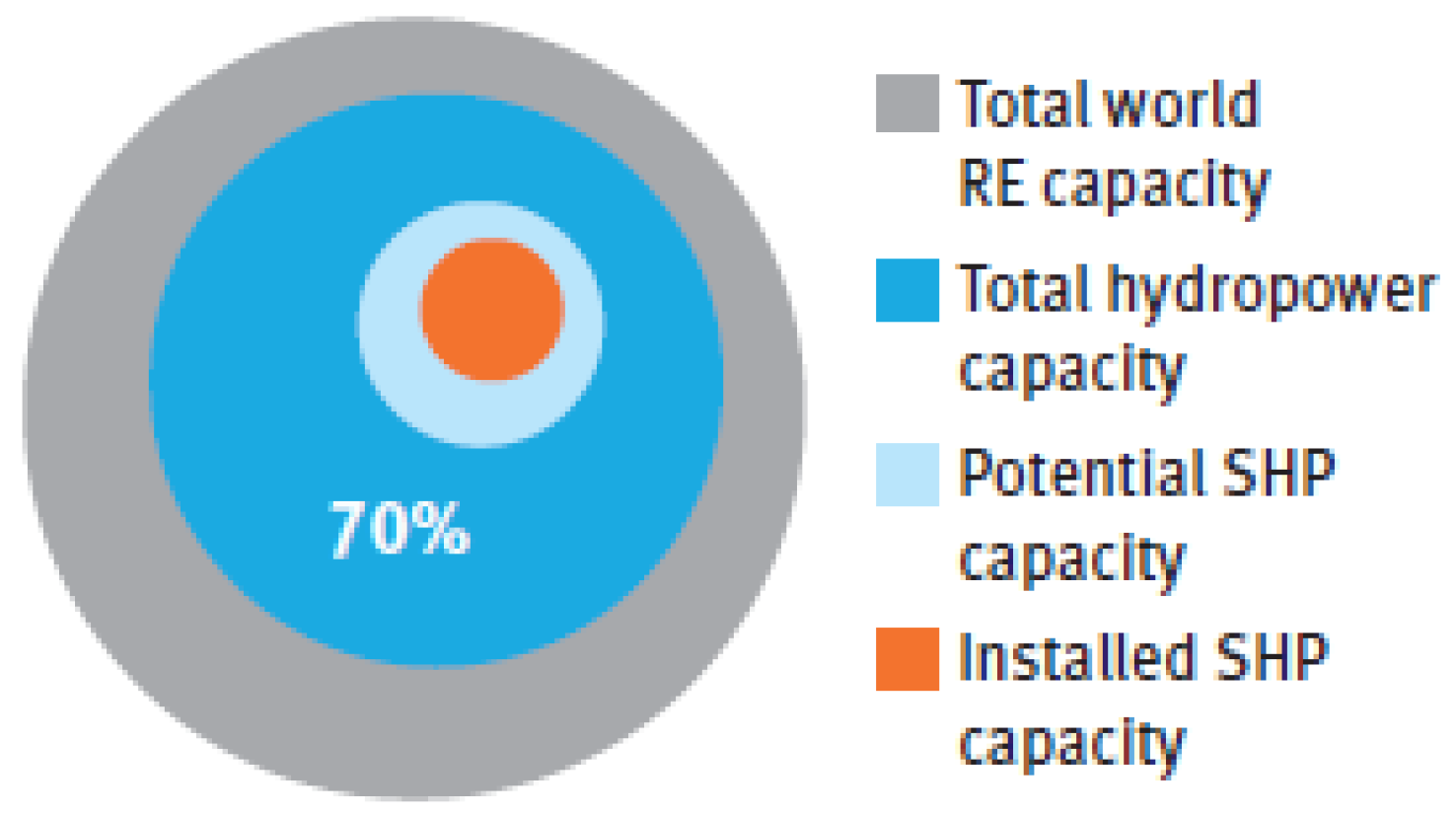


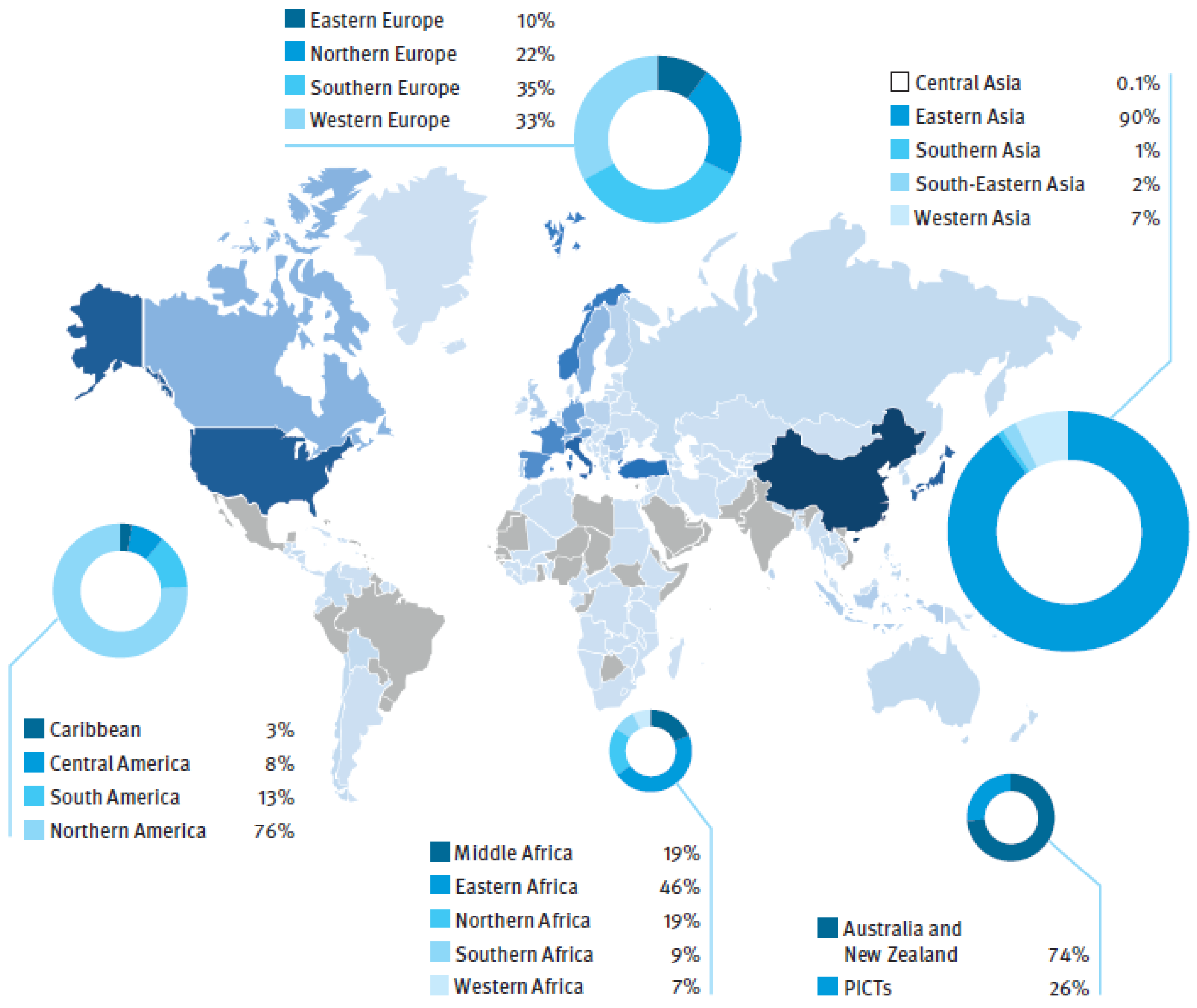

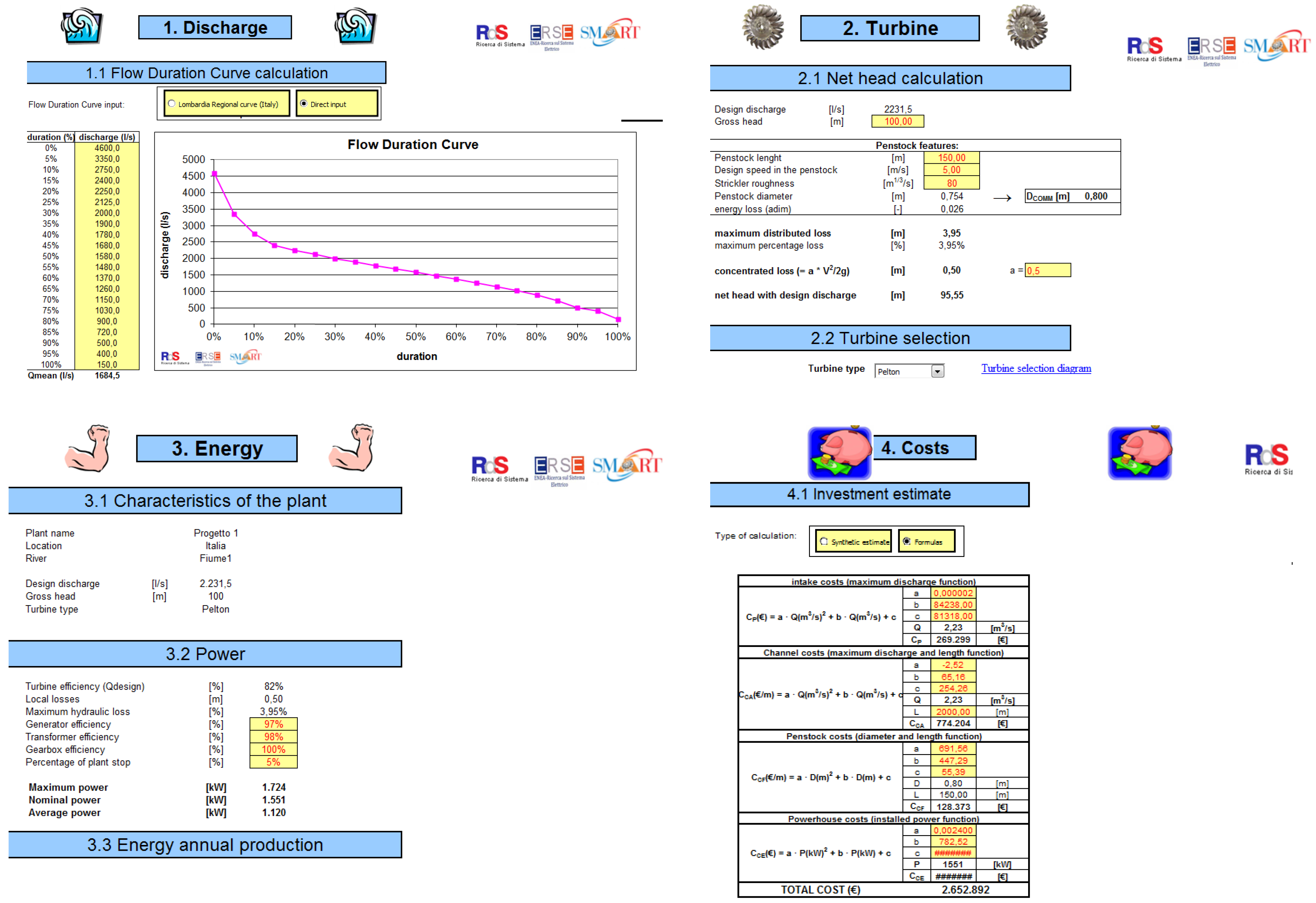






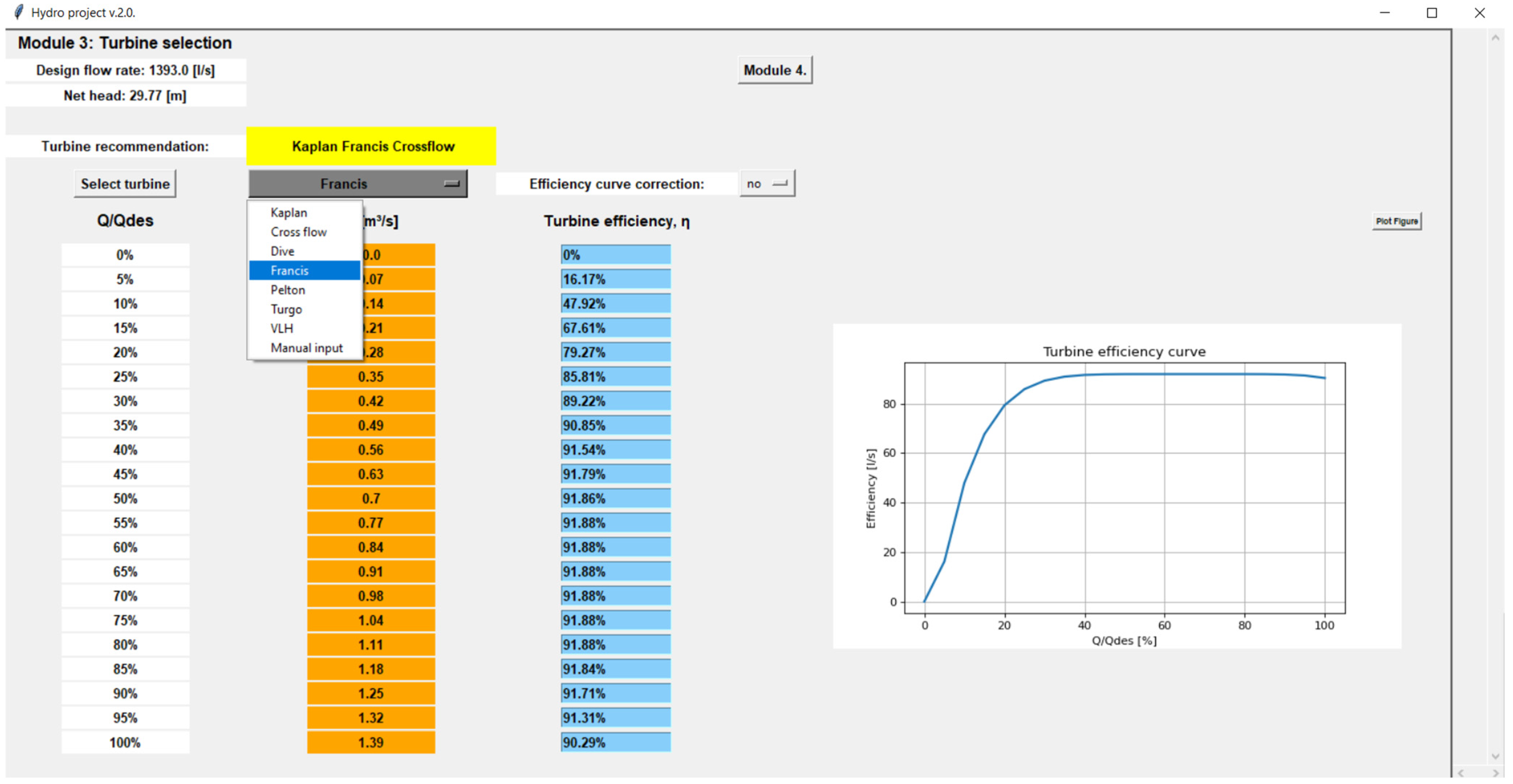

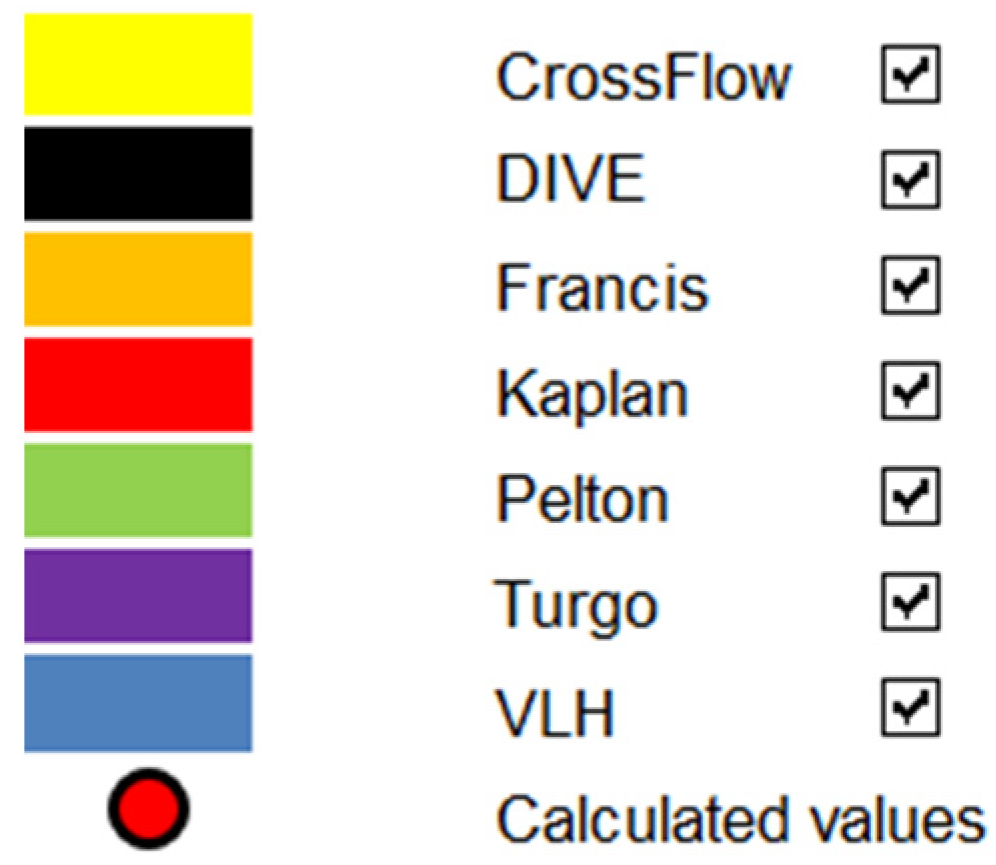
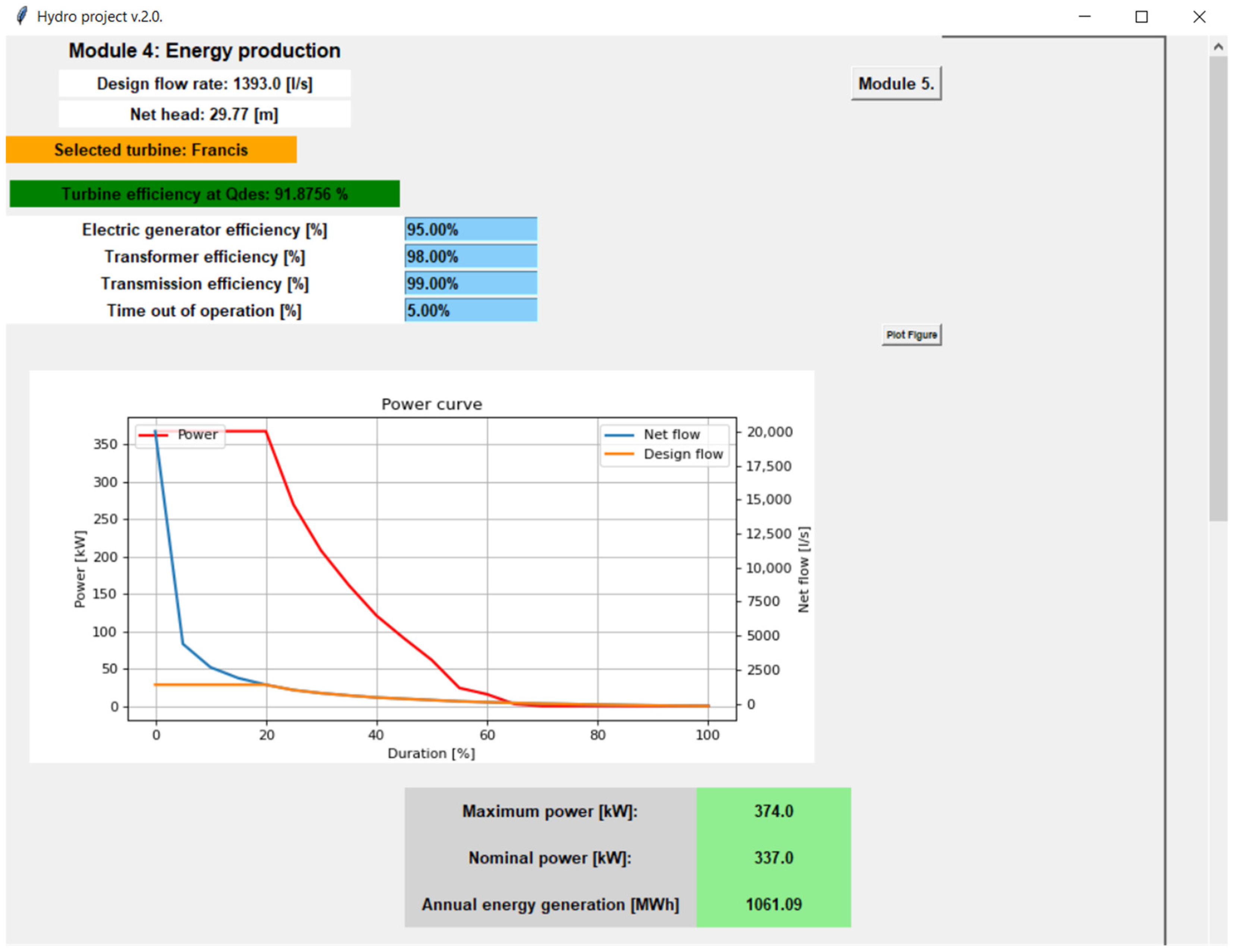







| Software Tools | Features | ||||||
|---|---|---|---|---|---|---|---|
| Name | Developer | Applicable Countries | Hydrology | Power and Energy | Coasting | Economic Evaluation | Preliminary Design |
| Integrated method for power analysis (IMP) | National Resources Canada and POWEL | International | Model | + | - | - | - |
| RetScreen® | National Resources Canada | International | FDC | + | + | + | - |
| PEACH | ISL Bureau d’Ingenieurs Conseils, Paris, France | International | FDC | + | + | + | + |
| Hydropower Evaluation Software (HES) | Department of Energy, Idaho Engineering and Environmental Laboratory, USA | USA | MAF | - | - | - | - |
| SMART Mini-Hydro | ERSE SpA, Milan, Italy | Italy | FDC | + | + | + | - |
| Hydrohelp | Gordon J.L and OEL-HydroSys, Canada | International | FDC | + | + | + | - |
| SHP Atlas on the Internet | Features | |||||||||
|---|---|---|---|---|---|---|---|---|---|---|
| Name | Developer | Applicable Countries | Accessibility | Hydrology | Power and Energy | Possible SHP Sites | Economic Evaluation | Proximity Information | SHP Renovation | Accounting for Other Water Uses, Minimum Flow Releases |
| NVE Atlas. Potential for SHP plants | Norwegian Water Resources and Energy Directorate (NVE), Trondheim | Norway | Open access, interactive web-based maps | MAF | + | + | + | + | - | - |
| Virtual Hydropower Prospector (VHP) | Idaho National Laboratory, Idaho | USA | Open access, interactive web-based maps | MAF | + | + | + | + | + | - |
| RHAM | Kerr Wood Leidal Associates Ltd. (KWL) | British Columbia, Canada | Open access, interactive web-based maps | MAF, FDC | + | + | + | + | - | + |
| Hydrobot | Nick Forrest Associates Ltd. et al. | Scotland | Limited access | FDC | + | + | + | + | - | + |
| VAPIDRO ASTE | ERSE SpA, Milan | Italy | Open access, interactive web-based maps | MAF | + | + | + | + | - | + |
| Parameter | From [22] | New Software | Difference [%] |
|---|---|---|---|
| Selected turbine | VLH | VLH | - |
| Maximum turbine power [kW] | 380 | 383 | 0.7% |
| Nominal power [kW] | 368 | 344 | −6.5% |
| Average power [kW] | 377 | 312 | −17.2% |
| Electricity produced [MWh] | 2768 | 2298 | −16.9% |
Disclaimer/Publisher’s Note: The statements, opinions and data contained in all publications are solely those of the individual author(s) and contributor(s) and not of MDPI and/or the editor(s). MDPI and/or the editor(s) disclaim responsibility for any injury to people or property resulting from any ideas, methods, instructions or products referred to in the content. |
© 2023 by the authors. Licensee MDPI, Basel, Switzerland. This article is an open access article distributed under the terms and conditions of the Creative Commons Attribution (CC BY) license (https://creativecommons.org/licenses/by/4.0/).
Share and Cite
Guzović, Z.; Barbarić, M.; Bačelić Medić, Z.; Degiuli, N. New Software for the Techno–Economic Analysis of Small Hydro Power Plants. Water 2023, 15, 1651. https://doi.org/10.3390/w15091651
Guzović Z, Barbarić M, Bačelić Medić Z, Degiuli N. New Software for the Techno–Economic Analysis of Small Hydro Power Plants. Water. 2023; 15(9):1651. https://doi.org/10.3390/w15091651
Chicago/Turabian StyleGuzović, Zvonimir, Marina Barbarić, Zlatko Bačelić Medić, and Nastia Degiuli. 2023. "New Software for the Techno–Economic Analysis of Small Hydro Power Plants" Water 15, no. 9: 1651. https://doi.org/10.3390/w15091651
APA StyleGuzović, Z., Barbarić, M., Bačelić Medić, Z., & Degiuli, N. (2023). New Software for the Techno–Economic Analysis of Small Hydro Power Plants. Water, 15(9), 1651. https://doi.org/10.3390/w15091651








